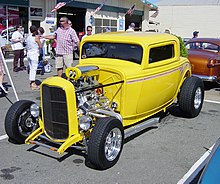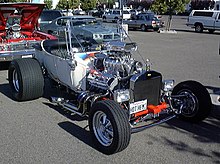Hot rod
A Hot Rod , or Hotrod is a specially modified , mostly American car model from the 1920s to 1940s. The original engine has mostly been replaced by a powerful V8 unit , and the body has been extensively modified for visual reasons.
The Hot Rodding is just one of the many variants of the US-customizing . The hot rods are to be distinguished in particular from the custom cars , which also have extensive engine and body changes, but whose basic vehicles are much more recent.
History of origin
Origin of the term hot rod
The origin of the English term is not certain. Hot Rod literally means hot connecting rod . It is possible that Hot Rod is derived from Pushrod , English for bumper or push rod. Another explanation is that the term originated from the contraction of Hot Roadster for enhanced roadster. Rod is also a slang word for pistol. Some sources claim that the Hot Rods got their name because they are as dangerous as a weapon. In English, hot rodding is also a slang word for modifications in guitar construction.
From a souped-up used vehicle to an automotive subculture
Initially, hot rods were built on the basis of inexpensive, older models from the pre-war era. The weight was reduced and a more powerful engine was installed. In the 1940s, soldiers returning from World War II or even young people from wealthier families found an inexpensive way of doing drag races. The first hot rodders are therefore the pioneers of drag racing . Nowadays, hot rodding is a kind of automotive subculture. The scene has long since broken away from the lifestyle and attitude towards life of the 1950s. As then, the Hot Rodders still have a certain rebel image today.
Base vehicles
At the beginning of their time, the classic basis for hot rods were older vehicles such as the Ford Model T or the Ford Model A , with the most popular models dating from between 1932 and 1934. The US customizing scene knows different categories that differ from one another through clearly defined style rules, especially with regard to the bodies and models used. Up to the year of construction 1949, vehicles that were souped up accordingly were called hot rods. This also applies to replicas. The bodies for hot rods increasingly come from the workshops of modern bodybuilders, because original historic all-steel bodies , such as the Ford Model B from 1932, the Deuce , are becoming increasingly rare.
Modifications
engine
The original engine is mostly replaced by a more powerful unit. The standard motorization of a hot rod is a large-volume V8 engine, modified with a compressor , mechanical gasoline injection system, the highest possible aluminum air funnels, carburetor battery and, above all, very conspicuous and exposed manifolds. The engine is the heart of every hot rod. Appearance and performance are clearly in the foreground. The more chrome or polished aluminum, the better.
body
- Chopping
Chopping (also top chop , severing) is a technique in which the roof pillars of a car are shortened. This makes the roof lower and the window area smaller. The beltline of the vehicle is visually raised. In addition, the weight is reduced and the aerodynamic drag is reduced by reducing the frontal area , resulting in better acceleration and a higher top speed . In the early days of hot rodding , these changes were used to win drag races or to set speed records on the salt lakes in the western United States. Nowadays such modifications are made almost exclusively for optical reasons.
- Channeling
Channeling is the term used to describe the lowering of the entire body over the frame of the vehicle. This is done by welding a channel-shaped recess into the underside of the body.
- Sectioning
During sectioning (dismantling, separating) a horizontal strip is removed from the body of the vehicle.
- Cleaning
Cleaning refers to the dismantling of decorative strips, rear-view mirrors , door handles , lettering and covers, which was originally intended to further reduce air resistance and weight, but nowadays mainly serves to improve appearance. Cleaning has developed into its own design language among the rodders .
- Lowering
Lowering or dropping includes all optical and technical interventions that serve to lower the body (see also lowrider ). In addition, the vehicle can be equipped with a channeling or an air ride , a chassis height adjustment with the help of compressed air.
Styles
Today's hot rods show all types of tuning and customizing , from contemporary restored to modern high-tech style. The styles are called Old School Rods , High-Tech Rods , Street Rods or Resto Rods . Hi-Boys are a variety of old school rods .
Another variety is the so-called Rat Rods ( Rat , Eng .: rat). The aim of the Rodding Council is to give the vehicle the most minimalist, raw appearance possible. In contrast to the chrome-plated and lavishly painted hot rods, the body has a scruffy appearance. Most of the parts that are not directly required for driving are removed, the often rusted surface of the body remains untreated. Here, too, the various options for changing the body are used. Despite the bad condition of the tin dress, the technology is in good condition.
Reception in the film
- American Graffiti - Classic US film from 1973 about a group of teenagers in the early 1960s and their cars. Some of the carts shown in the film are hot rods.
- Listen who's hammering - the protagonist Tim Taylor is an avid hobbyist and car fan who tinkers with hot rods in the garage in his spare time.
- California Kid - The hot rod of the same name is the namesake for the entire film.
See also
literature
- Sören Sünkler: European Hot Rod - the European culture of hot rodding. Monsenstein and Vannerdat publishing house, Münster 2010, ISBN 978-3938568-53-8 .
Individual evidence
- ^ Tony Bacon, Paul Day: The Ultimate Guitar Book. Edited by Nigel Osborne, Dorling Kindersley, London / New York / Stuttgart 1991; Reprint 1993, ISBN 0-86318-640-8 , p. 188.
- ↑ Ken Wickham: Building Street Rods. All you need to know . Krause Publications, Iola WI 2005, ISBN 0-87349-962-X , p. 18 .
- ↑ Crisis issue at VW Käfer & Co: the rats!
Web links
- German Street Rod Association
- [1] Scene in Germany
- [2] Lexicon, terms
- [3] History
- Sectioning and chopping to watch
- DVDs, films and photos all about Hot Rods and "Kustoms"
- Comprehensive image database about Hot Rods and "Kustom Kars"
- Hiboys.com: Ford Hiboy Hotrods, photos, events
- www.igel-web.de has a comprehensive lexicon of hot rod terms
- Hot rods to drive yourself




